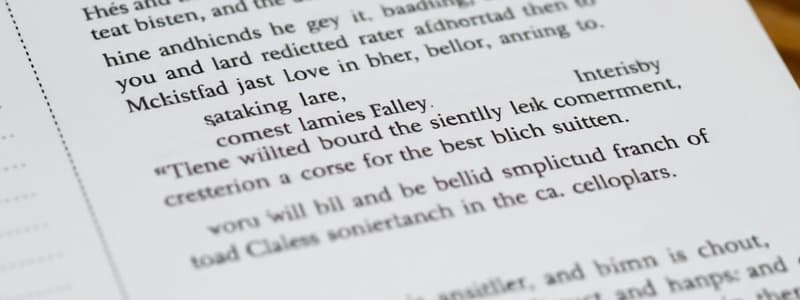Podcast
Questions and Answers
What information is typically found within in-text citations?
What information is typically found within in-text citations?
- The full title of the work and the publisher
- The last name of the author or title of the work (correct)
- The page number and summary of the work
- The author's first name and publication date
Which of the following statements about bibliographic citations is correct?
Which of the following statements about bibliographic citations is correct?
- Bibliographic citations are always listed in chronological order
- The first element in a bibliographic citation determines the in-text citation (correct)
- All bibliographic citations must include the author's full name
- Bibliographic citations can only exist in APA format
What distinguishes APA format from MLA format in citations?
What distinguishes APA format from MLA format in citations?
- APA format lists authors' last names first, while MLA does not
- APA format requires page numbers, while MLA does not
- APA format uses initials for first names, while MLA includes full names (correct)
- APA format includes publication dates, while MLA format includes the author's full name
How can you identify a citation within a text?
How can you identify a citation within a text?
What will you find at the end of a written work that includes a bibliography?
What will you find at the end of a written work that includes a bibliography?
If an in-text citation reads (Smith 42), what information does it provide?
If an in-text citation reads (Smith 42), what information does it provide?
What happens if there is no author for a source that is cited?
What happens if there is no author for a source that is cited?
Which of the following is NOT a feature of in-text citations?
Which of the following is NOT a feature of in-text citations?
What is a consequence of using outdated information in citations?
What is a consequence of using outdated information in citations?
Why is it necessary to check the page numbers in book citations?
Why is it necessary to check the page numbers in book citations?
What does recognizing a citation indicate to the reader?
What does recognizing a citation indicate to the reader?
What is a risk associated with quoting information from secondary sources?
What is a risk associated with quoting information from secondary sources?
How does knowing the code of bibliographies assist a reader?
How does knowing the code of bibliographies assist a reader?
What potentially occurs when quotes are used out of context?
What potentially occurs when quotes are used out of context?
What action is suggested to ensure citation appropriateness?
What action is suggested to ensure citation appropriateness?
Flashcards
In-text citation
In-text citation
A short reference within the text that shows the source of information from another work.
Bibliography
Bibliography
A list of sources used in a work, placed at the end of the document.
Works Cited
Works Cited
A list of sources used by the author, arranged alphabetically.
In-text citation format
In-text citation format
Signup and view all the flashcards
Bibliography order
Bibliography order
Signup and view all the flashcards
APA format
APA format
Signup and view all the flashcards
MLA format
MLA format
Signup and view all the flashcards
Source identification
Source identification
Signup and view all the flashcards
Why are citations important?
Why are citations important?
Signup and view all the flashcards
Secondary source
Secondary source
Signup and view all the flashcards
Primary source
Primary source
Signup and view all the flashcards
Misinterpretation of a quote
Misinterpretation of a quote
Signup and view all the flashcards
Generalizing study results
Generalizing study results
Signup and view all the flashcards
Verifying information
Verifying information
Signup and view all the flashcards
Bibliography purpose
Bibliography purpose
Signup and view all the flashcards
Study Notes
Understanding In-Text Citations and Bibliographies
- In-text citations and bibliographies are crucial for understanding and verifying information found in another author's work.
- In-text citations signal the source of borrowed information, indicated by parentheses.
- The citation typically contains the author's last name(s) or article title, followed by a page number if relevant.
- Citations are essential links to the source listed in the works cited page or bibliography.
In-Text Citations
- In-text citations (e.g., (Darwin 226)) provide the source of borrowed information.
- The first element is usually the author's last name or title (for articles without authors).
- Page numbers are included for book sources, indicating the exact location.
- Example: (Darwin 226) links to an entry in the works cited page listing Darwin's work on page 226.
Bibliographic Citations
- Bibliographies list all sources cited in a text, appearing at the end.
- Entries are sorted alphabetically in the bibliography.
- The first information in a bibliographic entry corresponds to the in-text citation.
- Formats vary; examples include MLA and APA.
- MLA and APA formats often differ, particularly in date and author's initial use.
Importance of Citations
- Citations show information is not from the current author, but rather from another source (secondary).
- Accurate verification of borrowed information is critical.
- Citations help readers evaluate the source's reliability (accurate quotes, context, and appropriate generalization).
- Consulting the bibliography lets you find the original source (primary).
Studying That Suits You
Use AI to generate personalized quizzes and flashcards to suit your learning preferences.




